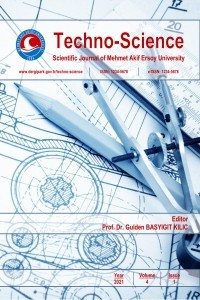Assessment of rainwater quality obtained from a suburban area in Nigeria based on the Physico-chemical properties
Assessment of rainwater quality obtained from a suburban area in Nigeria based on the Physico-chemical properties
Water is important in the daily activities of living things. The sources could be from the surface or ground. Rainwater is known to be pure, but its use could be reduced due to contaminants due to industrial, agricultural, traffic activities and other natural sources. Many research works have been undertaken on water pollution to provide information on the outcome for use in policymaking and monitoring. The location of this study has little or no information with regards to environmental safety. Therefore, the aim of this study was to assess the rainwater quality (July 2018 - June 2019) with reference to the physicochemical parameters. Standard methods were used in the assessment process. The results showed the mean results as follows: Total Dissolved Solids (TDS - 22.92 mg L L-1), Temperature (28.58oC), pH (6.83), Electrical Conductivity (EC - 45.3 µS/cm), and Free CO2 (22.0 mg L L-1). Statistical analyses (coefficient of variation (%)) depicted high variations in TDS, EC, and Free CO2.The only pH was skewed to the left.The results compared well with WHO standards and other references used. The present situation at the study location revealed a safe environment, but it is recommended that constant monitoring should be put in place by relevant stakeholders.
Keywords:
Rainwater, Oba-Ile pH, contaminants, WHO standards,
___
- 1. Abulude F. O and Fagbayide S.D. Nitrate in Drinking Water: How Safe is This in Africa and Asia? AnaleleUniversitatii din Oradea, SeriaGeografie. Year XXVIII, no. 1//2018 (June), 2018; 28-35. 2. Al Aizari H, Labkiri A, Fadli M, Albaseer S. Quality assessment of groundwater in Dhamar city, Yemen. International Journal of Environment, 2017;6(4): 56-71. 3. Shrestha, S.; Kazama, F. and Nakamura, T. Use of principal component analysis, factor analysis and discriminate analysis to evaluate spatial and temporal variations in water quality of the Mekong River. Journal of Hydroinformatics. 2008;10(1): 43- 56. 4. Muangthon, S. Assessment ecosystem of the Lamtakong River Basin (Thailand) using multivariate statistical techniques. Review of Integrative Business and Economics Research. 2015;4:198-216. 5. Yu, V. L. Legionella pneumophila, p. 2424-2435. In G. L. Mandell, J. E. Bennett, and R. Dolin (ed.), Principles and practice of infectious diseases, 5th ed., vol. 2. Churchill Livingstone, Philadelphia, PA.2000. 6. Ahmed W, Vieritz A,Goonetilleke A, and Gardner T. Health Risk from the Use of Roof-Harvested Rainwater in Southeast Queensland, Australia, as Potable or Non potable Water, Determined Using Quantitative Microbial Risk Assessment. Applied Environmental Microbiology. 2010;76(22): 7382–7391. 7. Heyworth J.S, Glonek G, Maynard EJ, Baghurst PA, and Finlay-Jones J. Consumption of untreated tank rainwater and gastroenteritis among young children in South Australia. International Journal of Epidemiology, 2006;35(4):51–1058, https://doi.org/10.1093/ije/dyl105. 8. Rappler. What are the common rainy season diseases? https://www.rappler.com/move-ph/issues/disasters/102032-rainy-season-diseases-signs-prevention. Update 9th August 2015. 9. Onwudiegwu, C. A., Ezeh, G.C., andObioh, I.B. Trace Metals in Total Atmospheric Depositions (TAD) of a Nigerian Island. Journal of Atmospheric Pollution. 2016;4(1):15-22. 10. Abulude, F. O., Ndamitso, M. M., and Abdulkadir, A. Environmental Situation of an Agricultural Area in Akure, Nigeria, Based on Physico-Chemical Properties of Rainwater. Pollution. 2017;4(2): 317-325, Spring 2018 DOI: 10.22059/poll.2017.242241.322. 11. Limgis. Methodology: Physico-chemical and biological analyses of water. Limnology.2001. 12. Eruola A.O, Ufoegbune G.C, Eruola A.O, Awomeso J.A, AdeofinC. O, Idowu O.A, and Sowunmi A. Qualitative and Quantitative Assessment of Rainwater Harvesting from Rooftop Catchments: Case Study of Oke-Lantoro Community in Abeokuta, Southwest Nigeria. European Water. 2010:32:47-56. 13. Bada B. S., Olatunde K. A. and Bankole O. D.Chemical and Physical Properties of Harvested Rainwater from Different Roofing Sheets in Abeokuta, Ogun State. Hydrology for Disaster Management. Special Publication of the Nigerian Association of Hydrological Sciences. 2012;173-170.
- 14. SDWF. TDS and pH. TDS and pH Fact Sheet. What are TDS? https://www.safewater.org/fact-sheets-1/2017/1/23/tds-and-ph. 2017. Accessed 23rd November, 2018. 15. Kumar S. Physico- Chemical Characterization of Rain Water Collected from Industrial Areas of Hisar, India. J. Ecophysiol. Occup. Hlth. 2016;16(3&4):72–77. 16. Demirak A, Balci A, Karaoglu H, and Tosmur B. Chemical characteristics of rain water at an urban site of south western Turkey. Environmental Monitoring Assessment.2006;123(1-3):271-83. 17. O'Hogain, S, McCarton, L, McIntyre, N, Pender, J, Reid, A. Physicochemical and microbiological quality of water from a pilot domestic rainwater harvesting facility in Ireland, Water and Environment Journal. 2011;25(4):489-494, 2011,doi:10.1111/j.1747-6593.2010.00244.x. 18. BudiwatiTuti, SetyawatiWiwiek, and Tanti Dyah Aries. Chemical Characteristics of Rainwater in Sumatera, Indonesia, during 2001–2010. International Journal of Atmospheric Sciences, vol. 2016, Article ID 1876046, 11 pages, 2016. https://doi.org/10.1155/2016/1876046. 19. Ministry of Environment, State of Environment Report in Indonesia. The State Ministry of Environment-Indonesia, Jakarta, Indonesia, 2007. 20. Chapman, Heather; Huston, Rob; Gardner, Ted; Chan, Andrew, and Shawl, Glen. Chemical Water Quality and Health Risk Assessment of Urban Rainwater Tanks [online]. In: Delectic, Ana (Editor); Fletcher, Tim (Editor). 7th International Conference on Urban Drainage Modelling and the 4th International Conference on Water Sensitive Urban Design; Book of Proceedings. [Clayton, Vic.]: Monash University, 2006: 509-516. 21. Wurts W.A and Durborow R.M. Interactions of pH, Carbon Dioxide, Alkalinity and Hardness in Fish Ponds. Southern Regional Aquaculture Center. SRAC Publication. 1992; No. 464.
- Yayın Aralığı: Yılda 2 Sayı
- Başlangıç: 2018
- Yayıncı: Burdur Mehmet Akif Ersoy Üniversitesi
Sayıdaki Diğer Makaleler
An overview of the medical waste disposal of Turkey
Onur İNAN, Kazım KUMAŞ, Ali Özhan AKYÜZ
A STUDY ON ESTIMATING OF THE LANDFILL GAS POTENTIAL FROM SOLID WASTE STORAGE AREA IN SIVAS, TURKEY
İlknur ŞENTÜRK, Başak YILDIRIM
Francis ABULUDE, Oluwagbayıde SAMUEL DARE, Akınyınka AKINNUSOTU
